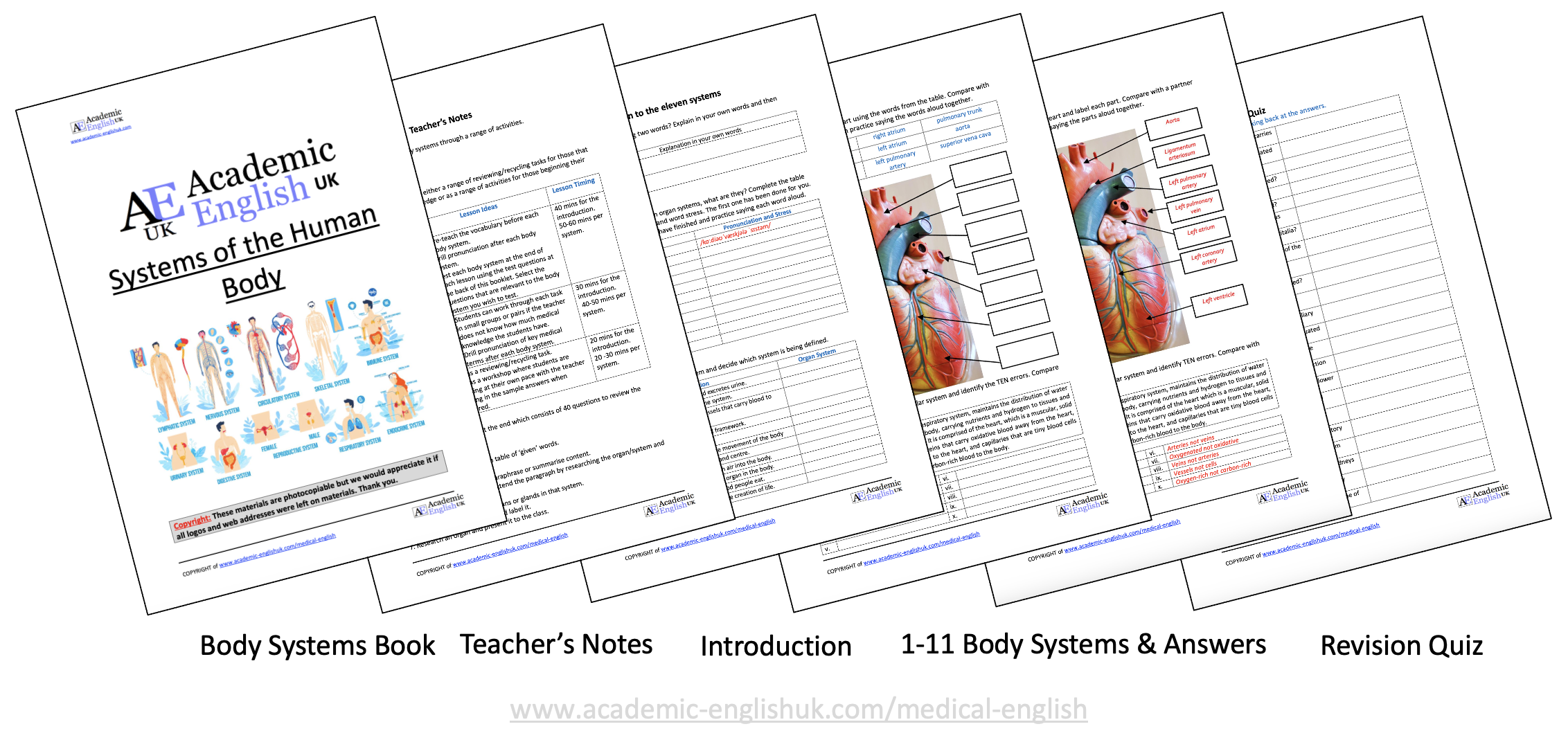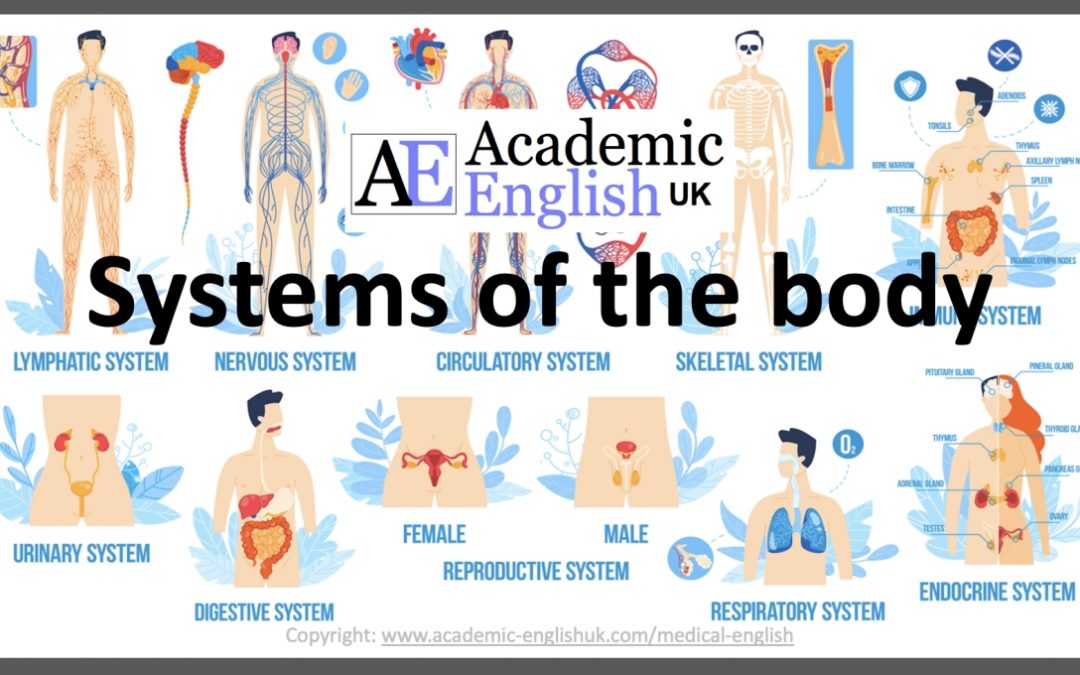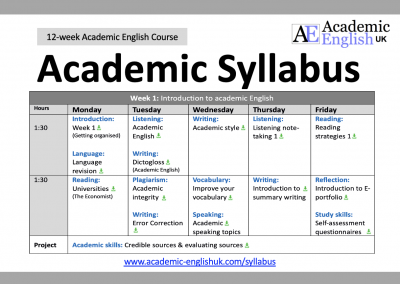Medical English: Systems of the Body
What are the systems of the body?
Organs of the human body are commonly grouped into eleven systems. Each body system includes organs and structures that serve a common purpose. The systems are highly interdependent, working together to sustain life and enable interaction with the surrounding environment (OpenMD, 2024).
Medical English Worksheets / Lessons
Click on any link to be taken to the download

Free Lesson: An introduction to the systems of the body
 FREE LESSON: An introduction to the 11 systems of the body [new 2024]
FREE LESSON: An introduction to the 11 systems of the body [new 2024]
This worksheet has been designed to help students review/recycle or learn the eleven systems of the body and can be an introduction for the systems worksheets. It includes writing definitions, discovering each system along with its pronunciation, and reading definitions and identifying which system is being defined. Level: ***** [B2/C1] TEACHER MEMBERSHIP / INSTITUTIONAL MEMBERSHIP
The Eleven Systems of the Body 1-6
The Cardiovascular System (new 2024)
This lesson has been designed to help students review/recycle or learn about the cardiovascular system. It contains a range of exercises such as labelling a heart diagram, reading a definition of this system and identifying errors, writing about pulmonary and systemic circulation and a summarising task. Example worksheet Level: ***** [B2/C1] TEACHER MEMBERSHIP / INSTITUTIONAL MEMBERSHIP
The Digestive System (new 2024)
This lesson has been designed to help students review/recycle or learn about the digestive system. It contains a range of exercises such as labelling the organs of this system, reading comprehension about how this system works, and writing about the stomach using given prompts. Example worksheet Level: ***** [B2/C1] TEACHER MEMBERSHIP / INSTITUTIONAL MEMBERSHIP
The Endocrine System (new 2024)
This lesson has been designed to help students review/recycle or learn about the endocrine system. It contains a range of exercises such as writing a definition of this system using given prompts, researching and table completion activity and labelling the thyroid. Example worksheet Level: ***** [B2/C1] TEACHER MEMBERSHIP / INSTITUTIONAL MEMBERSHIP
The Integumentary System (new 2024)
This lesson has been designed to help students review/recycle or learn about the integumentary system. It contains a range of exercises such as completing a definition of this system using given words, a summarising task, labelling the structure of the skin, reading comprehension about the skin, and identifying word stress in the given words Example worksheet Level: ***** [B2/C1] TEACHER MEMBERSHIP / INSTITUTIONAL MEMBERSHIP
The Lymphatic System (new 2024)
This lesson has been designed to help students review/recycle or learn about the lymphatic system. It contains a range of exercises such as completing a definition of this system using a mind map, identifying word stress in given words, completing a gap fill task about the lymph nodes, and writing about the thymus using given prompts. Example worksheet Level: ***** [B2/C1] TEACHER MEMBERSHIP / INSTITUTIONAL MEMBERSHIP
The Muscular System (new 2024)
This lesson has been designed to help students review/recycle or learn about the muscular system. It contains a range of exercises such as completing a definition of this system using given words, labelling the muscles in the leg, researching and writing about two muscles in the leg, and writing about the types of muscle tissue using given prompts. Example worksheet Level: ***** [B2/C1] TEACHER MEMBERSHIP / INSTITUTIONAL MEMBERSHIP
The Eleven Systems of the Body 7-11
The Nervous System (new 2024)
This lesson has been designed to help students review/recycle or learn about the nervous system. It contains a range of exercises such reading comprehension about this system, completing a gap fill task about the somatic nervous system, reading about the autonomic nervous system, labelling the sympathetic and parasympathetic nervous systems, and a summarising task. Example worksheet Level: ***** [B2/C1] TEACHER MEMBERSHIP / INSTITUTIONAL MEMBERSHIP
The Reproductive System (new 2024)
This lesson has been designed to help students review/recycle or learn about the reproductive system. It contains a range of exercises such as making complete sentences about this system by matching two parts, labelling the female and male reproductive systems and a summarising task. Example worksheet Level: ***** [B2/C1] TEACHER MEMBERSHIP / INSTITUTIONAL MEMBERSHIP
The Respiratory System (new 2024)
This lesson has been designed to help students review/recycle or learn about the respiratory system. It contains a range of exercises such as writing a definition of this system using given prompts, completing a gap fill task about how this system works, labelling a model of the right lung and researching how the left lung differs from the right lung. Example worksheet Level: ***** [B2/C1] TEACHER MEMBERSHIP / INSTITUTIONAL MEMBERSHIP
The Skeletal System (new 2024)
This lesson has been designed to help students review/recycle or learn about the skeletal system. It contains a range of exercises such as labelling the bones of a skeleton, researching the five types of bone and table completion, writing about the role of bone marrow using the given prompts, and researching and writing about platelets. Example worksheet Level: ***** [B2/C1] TEACHER MEMBERSHIP / INSTITUTIONAL MEMBERSHIP
The Urinary System (new 2024)
This lesson has been designed to help students review/recycle or learn about the urinary system. It contains a range of exercises such as writing about this system using the given prompts, completing a gap fill task about the kidneys, making sentences about the bladder by matching two parts and researching the four parts of the bladder. Example worksheet Level: ***** [B2/C1] TEACHER MEMBERSHIP / INSTITUTIONAL MEMBERSHIP
The Eleven Systems of the Body PDF Book

The 11 Systems of the Body PDF Book [new 2024]
This booklet has been designed to help students review/recycle or learn about the eleven systems of the body. The booklet contains teacher’s notes, introductory tasks, and activities such as gap fills, matching exercises, reading comprehension, labelling tasks, writing exercises, pronunciation and word stress activities, research tasks and a quiz. Example worksheet Level: ***** [B2/C1] TEACHER MEMBERSHIP / INSTITUTIONAL MEMBERSHIP
Pay-per-Download
Terms & Conditions of Use
The Medical Academic Word List (MAWL)
 Medical Academic Word List Download (MAWL) [new 2023]
Medical Academic Word List Download (MAWL) [new 2023]
This is a download of the Medical Academic Word List in PDF format. It contains 623 medical and non-subject specific words, divided into 10 sublists based on frequency (sublist 1 = most frequent). Level: ***** [B2/C1] TEACHER MEMBERSHIP / INSTITUTIONAL MEMBERSHIP
An introduction to the MAWL (using synonyms)
 Introduction to the MAWL using synonyms: Sublist 1- 5 [new 2023]
Introduction to the MAWL using synonyms: Sublist 1- 5 [new 2023]
This is a great lesson to introduce the Medical Academic Word List (MAWL). It begins with a small explanation about the MAWL. This is then followed with a focus activity on sublist 1 by identifying possible synonyms, which helps students to become acquainted with the MAWL. The final activity is a sentence gap-fill sheet to consolidate understanding (two exercises: general & medical).The PDF book includes 5 lessons for sublists 1-5. Time: 30 mins per lesson / Example Level: *****[B2/C1] TEACHER MEMBERSHIP / INSTITUTIONAL MEMBERSHIP
*
 Medical Gap Fill Exercises (MAWL: Sublist 1-5) [new 2023]
Medical Gap Fill Exercises (MAWL: Sublist 1-5) [new 2023]
This lesson uses words from the MAW sublists 1-5. There are 10 sentence gap-fill exercises which focus on general & medical terms.These gap fill exercises are the same exercises as the Introduction to the MAWL lesson. Example Level ***** [B1/B2/C1] TEACHER MEMBERSHIP / INSTITUTIONAL MEMBERSHIP
*
Introduction to the MAWL using synonyms: Sublist 6 – 10 [new 2023]
This is a great lesson to introduce the Medical Academic Word List (MAWL). It begins with a small explanation about the MAWL. This is then followed with a focus activity on sublist 6 by identifying possible synonyms, which helps students to become acquainted with the MAWL. The final activity is a sentence gap-fill sheet to consolidate understanding (two exercises: general & medical).The PDF book includes 5 lessons for sublists 6-10. Example Time: 30 mins per lesson Level: *****[B2/C1] TEACHER MEMBERSHIP / INSTITUTIONAL MEMBERSHIP
*
Medical Gap Fill Exercises (MAWL: Sublist 6-10) [new 2023]
This lesson uses words from the MAW sublists 6-10. There are 10 sentence gap-fill exercises which focus on general & medical terms.These gap fill exercises are the same exercises as the Introduction to the MAWL lesson. Example Level ***** [B1/B2/C1] TEACHER MEMBERSHIP / INSTITUTIONAL MEMBERSHIP
Heart Disease Lessons
Reading Test: Heart Disease [new 2023]
This 789-word text discusses cardiovascular disease (CVD). It provides a detailed paragraph definition of CVD and focuses on two of the biggest causes: high blood pressure and high cholesterol. It also puts forward solutions in the form of treatment and prevention. The reading test includes: matching headings to paragraphs; true, false, not given; reference words; open answer questions; citations; and a vocabulary task. (Example) Level ***** [B2/C1] TEACHER MEMBERSHIP / INSTITUTIONAL MEMBERSHIP
Writing Summary: Heart Disease [new 2023]
This 789-word text discusses cardiovascular disease (CVD). It provides a detailed paragraph definition of CVD and focuses on two of the biggest causes: high blood pressure and high cholesterol. It also puts forward solutions in the form of treatment and prevention. The summary task includes: note-taking worksheet with key, summary writing exercise with one sample summary, and a critical thinking worksheet with suggested answers. (Example) Level ***** [B2/C1] TEACHER MEMBERSHIP / INSTITUTIONAL MEMBERSHIP
*
*
Listening Test: Heart Disease (CABG Procedure) [new 2023]
This short lecture explains how the mortality rate of cardiovascular disease has declined through the emergence of the coronary artery bypass graft (CABG). It talks about the CABG procedure and risks of open-heart surgery which involves single, double, triple or quadruple bypasses or the less invasive coronary angioplasty. The listening test includes: open answer questions; gap fill summary; true, false, not given; a matching exercise; a gap fill completion activity; and a summary identification task. (Example) Level ***** [B2/C1] / Video [06.30] / MP3 / PPT link in download / TEACHER MEMBERSHIP / INSTITUTIONAL MEMBERSHIP
Seminar Speaking: Heart Disease [new 2023]
This is a speaking seminar sheet that provides a range of questions for students to discuss together after they have done the reading and listening texts. The seminar provides students with an opportunity to discuss the content, share their opinions and build confidence in speaking. Level ***** [B2/C1] TEACHER MEMBERSHIP / INSTITUTIONAL MEMBERSHIP
Heart Disease PDF Book [new 2023]
AMAZING VALUE – Four lessons in one book: reading test, reading to writing summary writing, listening test & speaking seminar. Example TEACHER MEMBERSHIP / INSTITUTIONAL MEMBERSHIP
Dementia Lessons
Reading Test: Dementia [new 2023]
This 1000-word text discusses dementia. It provides an extended definition of dementia, key facts and stats connected to dementia, the four types of dementia, and the diagnosis and possible treatments of dementia. The reading test includes: matching headings to paragraphs; true, false, not given; reference words; open answer questions; citations; and a vocabulary task. (Example) Level ***** [B2/C1] TEACHER MEMBERSHIP / INSTITUTIONAL MEMBERSHIP
Writing Summary: Dementia [new 2023]
This 1000-word text discusses dementia. It provides an extended definition of dementia, key facts and stats connected to dementia, the four types of dementia, and the diagnosis and possible treatments of dementia. The summary task includes: note-taking worksheet with key, summary writing exercise with one sample summary, and a critical thinking worksheet with suggested answers. (Example) Level ***** [B2/C1] TEACHER MEMBERSHIP / INSTITUTIONAL MEMBERSHIP
*
*
Alzheimer’s is not normal aging and we can cure it – Samuel Cohen [new 2023]
TED TALK: This talk discusses what happens in the brain of someone with this disease. It describes the incidence rate, the economic challenges and the results of the latest experiments. Listening worksheets use a range of test type questions: open questions; multiple choice; true, false; gap fills and more. Example Level ***** [B2/C1] / Video [07.44] TEACHER MEMBERSHIP / INSTITUTIONAL MEMBERSHIP
*
The dementia village that’s redefining elder care – Yvonne van Amerongen [new 2023]
TED TALK: This talk describes what the new ‘dementia village’ looks like, how it has been set up to support dementia sufferers and why it works. Listening worksheets use a range of test-type questions: open questions; gap fills; true, false; multiple-choice; table completion and more. Example Level ***** [B2/C1] / Video [10.21] TEACHER MEMBERSHIP / INSTITUTIONAL MEMBERSHIP
Seminar Speaking: Dementia [new 2023]
This seminar worksheet provides a a number of questions based on the reading and listenings. Students refer to the reading text and their listening notes and discuss some of the key points made in all texts. The seminar sheet includes the sources so students can refer to specific evidence by author.. Level ***** [B2/C1] TEACHER MEMBERSHIP / INSTITUTIONAL MEMBERSHIP
Dementia PDF Book [new 2023]
AMAZING VALUE – Five lessons in one book: reading test, reading to writing summary writing, 2xlistening tests & speaking seminar. Example TEACHER MEMBERSHIP / INSTITUTIONAL MEMBERSHIP
Air Pollution Lessons
Reading Test: Air Pollution [new 2022]
This 756-word text explains how ambient air pollution is a serious environmental health problem around the world. It talks about how air pollution is measured, the causes and effects of air pollution and the current measures that are being implemented to reduce air pollution. The reading test includes: matching headings to paragraphs; true, false, not given; open answer questions; summary identification exercise; reference words and a vocabulary task. (Example) Level ***** [B2/C1] TEACHER MEMBERSHIP / INSTITUTIONAL MEMBERSHIP
Reading & Summary Writing Lesson: Air Pollution (new 2022)
This 756-word text explains how ambient air pollution is a serious environmental health problem around the world. It talks about how air pollution is measured, the causes and effects of air pollution and the current measures that are being implemented to reduce air pollution. The summary task includes: note-taking worksheet with key, summary writing exercise with one sample summary, and a critical thinking worksheet with suggested answers. (Example) Level ***** [B2/C1] TEACHER MEMBERSHIP / INSTITUTIONAL MEMBERSHIP
Listening Test: Air Pollution [new 2022]
This short 10:50 lecture introduces the global cost of air pollution. It talks about the most polluted cities around the world, it explains how much air pollution costs developing countries and it puts forward measures to decrease air pollution at a global, national and individual level. The listening test includes: open answer questions; true, false, not given; multiple choice; and a gap fill summary. (Example) Level ***** [B2/C1] / Video [10.50] / MP3 / PPT link in download / TEACHER MEMBERSHIP / INSTITUTIONAL MEMBERSHIP
Seminar Speaking: Air Pollution [new 2022]
This is a speaking seminar sheet that provides a range of questions for students to discuss together after they have done the reading and listening texts. The seminar provides students with an opportunity to discuss the content, share their opinions and build confidence in speaking. Level ***** [B2/C1] TEACHER MEMBERSHIP / INSTITUTIONAL MEMBERSHIP
Noise Pollution Lessons
Reading Test: Noise Pollution – the under-estimated threat to health
The text discusses what noise pollution is and how it has recently been recognised as harmful to health. The text explores recent empirical evidence into the detrimental effects of noise pollution and presents the W.H.O (2018) guidelines for reducing urban noise. The reading test worksheet includes: headings / T,F,NG / open answers / gap fill / information tables / reference words / vocabulary. (Example) Level ***** [B2/C1] TEACHER MEMBERSHIP / INSTITUTIONAL MEMBERSHIP
Noise Pollution: Reading & Summary Writing Lesson
The text discusses what noise pollution is and how it has recently been recognised as harmful to health. The text explores recent empirical evidence into the detrimental effects of noise pollution and presents the W.H.O (2018) guidelines for reducing urban noise. The summary writing task consists of a note-taking worksheet, a summary writing task, critical thinking questions, sample notes, a sample summary and sample critical thinking answers. Example. Level ***** [B2/C1] TEACHER MEMBERSHIP / INSTITUTIONAL MEMBERSHIP
Why Noise is bad for your health and what you can do about it. – Mathias Basner
TED TALK: This lecture discusses the rise in environmental noise and its psychological and physical effects. It proposes a number of possible solutions to control and reduce noise. Example. Level: ***** [B1/B2/C1] / Video [09:58] / TEACHER MEMBERSHIP / INSTITUTIONAL MEMBERSHIP
Noise Pollution Lesson PDF Book
AMAZING VALUE – Five lessons in one book. Introduction, definition, reading test, summary writing, lecture listening & seminar More information
TEACHER MEMBERSHIP / INSTITUTIONAL MEMBERSHIP
TED Talks Medical Listening Worksheets x20
How does at anesthesia work? TED-Ed Medicine (2016) (new 2023)
The focus of this short 4.42-minute lecture is to provide an explanation of how anesthesia works. It firstly looks at regional anesthesia and then moves on to the two types of general anesthetia: inhalational and intravenous. Finally, it explains how anesthesia has improved surgical techniques. Example Time: 60 minutes. Level ***** [B2/C1] Video [04.42] TEACHER MEMBERSHIP / INSTITUTIONAL MEMBERSHIP
How can we solve the antibiotic resistance crisis? TED-Ed Medicine (2020) (new 2023)
The focus of this short 6.00-minute lecture is to explain how bacteria has become resistant to antibiotics. It firstly looks at the uses of antibiotics, the discovery of antibiotics and the start of the resistance, and then moves on to the solutions and challenges. Example Time: 60 minutes. Level ***** [B2/C1] Video [06.00] TEACHER MEMBERSHIP / INSTITUTIONAL MEMBERSHIP
*
How bones make blood TED-Ed Medicine (2020) (new 2023)
The focus of this short 4.22-minute lecture is to explain how bone makes blood. It firstly looks at what bone consists of and the role of the stem cells in the bone marrow; it then describes what blood cancer is and how it evolves; after that it explains how a bone marrow transplant works before finally identifying potential donors. Example Time: 60 minutes. Level ***** [B2/C1] Video [04.22] TEACHER MEMBERSHIP / INSTITUTIONAL MEMBERSHIP
*
How does chemotherapy work? TED-Ed Medicine (2019) (new 2023)
The focus of this short 5.06-minute lecture is to explain how chemotherapy works. It firstly looks at how chemotherapy drugs were discovered; it then describes how these drugs are delivered into body and exactly how they kill the cells; after that it describes the side effects of chemotherapy along with how doctors manage these side effects; and it ends with some important statistics on diagnosis and remission. Example Time: 60 minutes. Level ***** [B2/C1] Video [05.06] TEACHER MEMBERSHIP / INSTITUTIONAL MEMBERSHIP
*
Why is it so hard to cure the common cold? TED-Ed Medicine (2022) (new 2023)
The focus of this short 5.03-minute lecture is to explain why it is so hard to cure the common cold. It firstly discusses some research on pleconaril; it then looks at the immune system and explains how it protects you; after that it discusses vaccines as a treatment and how they work before examining antiviral drugs and how they work; it then illustrates why one disease has been eradicated while another is challenging to eliminate; and finally, it looks at potential new treatments. Example Time: 60 minutes. Level ***** [B2/C1] Video [05.03] TEACHER MEMBERSHIP / INSTITUTIONAL MEMBERSHIP
*
What causes headaches? TED-Ed Medicine (2018) (new 2023)
The focus of this short 5.07-minute lecture is to explain the cause of headaches. It firstly looks at the cure for headaches in ancient Greece; it then classifies headaches into two types and defines both; after that it looks into four types of headaches and explains what happens in the head that causes the pain along with other symptomatic effects. Example Time: 60 minutes. Level ***** [B2/C1] Video [05.07] TEACHER MEMBERSHIP / INSTITUTIONAL MEMBERSHIP
*
What happens during a heart attack? TED-Ed Medicine (2017 ) (new 2023)
The focus of this short 4.40-minute lecture is to explain what happens during a heart attack. It firstly looks at the causes; it then identifies the symptoms; after that it describes the diagnosis; it then explains the treatment for heart attacks before finally putting forward some preventative measures. Example Time: 60 minutes. Level ***** [B2/C1] Video [04.40] TEACHER MEMBERSHIP / INSTITUTIONAL MEMBERSHIP
How does heart transplant surgery work? TED-Ed Medicine (2022) (new 2023)
The focus of this short 4.55-minute lecture is to explain how heart transplant surgery works. It firstly provides some statistics on heart transplants; it then describes who the potential recipients and the eligible donors are; after that it describes the surgery in detail before looking at some of the associated challenges; finally, it provides some survival-rate statistics. Example Time: 60 minutes. Level ***** [B2/C1] Video [04.55] TEACHER MEMBERSHIP / INSTITUTIONAL MEMBERSHIP
*
How does the immune system work? by TED-Ed Medicine (2018) (new 2023)
The focus of this short 5.09-minute lecture is to explain how the immune system works. It firstly looks at what the immune system protects you against; it then defines what the immune system is; after that it explains the role and the types of white blood cells and how they work together; it then identifies the bodily symptoms that help the immune system before finally explaining what happens to people with autoimmune diseases. Example Time: 1 hour. Level ***** [B2/C1] Video [05.09] TEACHER MEMBERSHIP / INSTITUTIONAL MEMBERSHIP
*
What is obesity? TED-Ed Medicine (2016) (new 2023)
The focus of this short 4.56-minute lecture is to explain what obesity is. It firstly discusses bodily fat in prehistoric times; it then looks at the period of history when being overweight was recognised as ill health; after that it explains the difference between being overweight and being obese; it then identifies the causes of obesity before looking at the effects of obesity and finally the way to improve obesity-related health issues. Example Time: 60 minutes. Level ***** [B2/C1] Video [04.56] TEACHER MEMBERSHIP / INSTITUTIONAL MEMBERSHIP
*
How do steroids affect your body? TED-Ed Medicine (2022) (new 2023)
The focus of this short 5.32 minute lecture is to explain how steroids affect your muscles and other parts of your body. It starts with a definition of steroids and the likely users; it then identifies the effects of steroids; after that it explains the medical use as well as the recreational use of steroids before discussing the undesired consequences of the latter. Example Time: 60 minutes. Level ***** [B2/C1] Video [05.32] TEACHER MEMBERSHIP / INSTITUTIONAL MEMBERSHIP
*
How do antidepressants work? by TED-Ed Medicine (2021) [new 2023]
The focus of this short 4.39-minute lecture is to provide an explanation of how antidepressants work. It firstly looks at how depression was treated in the past; it then looks at the discovery of the different antidepressant drugs, how they work and their side effects. EXAMPLE.Time: 60 minutes. Level ***** [B2/C1] Video [04.39] TEACHER MEMBERSHIP / INSTITUTIONAL MEMBERSHIP
Why haven’t we cured arthritis? by TED-Ed Medicine (2019) [new 2023]
The focus of this short 4.11-minute lecture is to explain why it is difficult to cure arthritis. It looks at how widespread the disease it; the common features of the different types of arthritis; the causes of osteoarthritis, rheumatoid arthritis and spondyloarthritis; the current treatments and the preventative measures. EXAMPLE. Time: 60 minutes. Level ***** [B2/C1] Video [04.11] TEACHER MEMBERSHIP / INSTITUTIONAL MEMBERSHIP
*
What is bipolar disorder? by TED-Ed Medicine (2017) [new 2023]
The focus of this short 5.58-minute lecture is to explain what bipolar disorder is. It firstly gives a definition of this disorder; it then compares two types of the condition. After that each type is explained in terms of the symptoms before discussing how people live with this disorder. It then goes into an analysis of the causes, the diagnosis, the medical treatments and the lifestyle changes that people with this condition can make. EXAMPLE.Time: 60 minutes. Level ***** [B2/C1] Video [05.58] TEACHER MEMBERSHIP / INSTITUTIONAL MEMBERSHIP
*
Performing brain surgery without a scalpel. by TED-Ed Medicine (2022) [new 2023]
The focus of this short 4.58-minute lecture is to describe how brain surgery can be performed using stereotactic radiosurgery. It explains what this treatment is, the process of this treatment and how it works, and then looks at the drawbacks, the benefits and other diseases that can be treated with stereotactic radiosurgery. EXAMPLE.Time: 60 minutes. Level ***** [B2/C1] Video [04.58] TEACHER MEMBERSHIP / INSTITUTIONAL MEMBERSHIP
*
How does laser eye surgery work? by TED-Ed Medicine (2019) [new 2023]
The focus of this short 5.17-minute lecture is to explain how laser eye surgery works. It firstly looks at the invention of keratomileusis and explains how this procedure can correct refractive errors. It then talks about excimer lasers, what they can do and how they work before finally explaining how the technique SMILE works. EXAMPLE.Time: 60 minutes. Level ***** [B2/C1] Video [05.17] TEACHER MEMBERSHIP / INSTITUTIONAL MEMBERSHIP
*
The dangers of mixing drugs by TED-Ed Medicine (2019) [new 2023]
The focus of this short 5.03-minute lecture is to inform of the dangers of mixing drugs. It starts by explaining when drug interactions happen; it then describes the two types of interactions; after that it gives examples of the interactions and what happens in the body during these interactions; and finally it looks at the new developments in science and technology.EXAMPLE.Time: 60 minutes. Level ***** [B2/C1] Video [05.03] TEACHER MEMBERSHIP / INSTITUTIONAL MEMBERSHIP
Why is pneumonia so dangerous? by TED-Ed Medicine (2020) [new 2023]
The focus of this short 4.07-minute lecture is to explain why pneumonia is so dangerous. It starts by explaining what happens when we breathe and the role of the alveoli; it then defines pneumonia and looks at the cause of this infection; after that it explains the symptoms of pneumonia, the treatment and susceptible populations before finally examining preventative measures. EXAMPLE.Time: 60 minutes. Level ***** [B2/C1] Video [04.07] TEACHER MEMBERSHIP / INSTITUTIONAL MEMBERSHIP
*
What is schizophrenia? by TED-Ed Medicine (2020) [new 2023]
The focus of this short 5.17-minute lecture is to discuss schizophrenia. It starts by talking about the initial, positive and negative symptoms of this condition; it then examines the possible causes of the disorder; and finally it looks at the different treatments available along with how they work and any side effects. EXAMPLE. Time: 60 minutes. Level ***** [B2/C1] Video [05.17] TEACHER MEMBERSHIP / INSTITUTIONAL MEMBERSHIP
*
What would happen if you didn’t sleep? by TED-Ed Medicine (2017) [new 2023]
The focus of this short 4.20-minute lecture is to explain what would happen if we didn’t sleep. It starts by looking at a case study of a teenager who didn’t sleep for sometime; it then talks about the external and internal signals that prepare our bodies for sleep; after that it informs us of the diseases and conditions that sleep deprivation may cause and it describes a rare genetic condition where people don’t sleep; and finally it examines what happens in the brain when we sleep. EXAMPLE. Time: 60 minutes. Level ***** [B2/C1] Video [04.20] TEACHER MEMBERSHIP / INSTITUTIONAL MEMBERSHIP
*
How does ultrasound work? by TED-Ed Medicine (2021) [new 2023]
The focus of this short 4.56-minute lecture is to describe how ultrasound works. It firstly describes how sound is created and uses bats and SONAR to clarify how it works; it then examines what ultrasound is used for in a medical context; after that it explains how fetal ultrasound works; and finally it evaluates the positive aspects of ultrasound. EXAMPLE. Time: 60 minutes. Level ***** [B2/C1] Video [04.56] TEACHER MEMBERSHIP / INSTITUTIONAL MEMBERSHIP
*
















